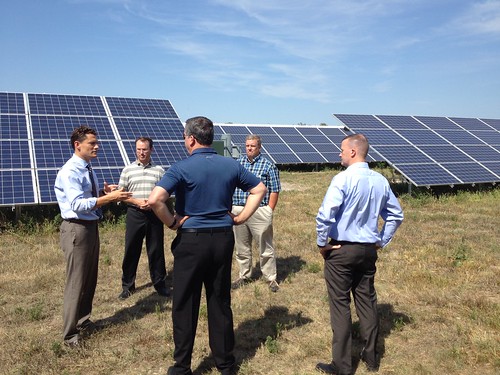
USDA Rural Development’s Rural Energy for America Program, commonly referred to as ‘REAP’, provides financial resources for rural agricultural producers and small businesses to help them improve their bottom line. REAP provides loan guarantees and small grants to support these producers and owners as they improve the energy efficiency of their operations and develop renewable energy sources.
Today, Secretary Vilsack announced hundreds of new projects like the one I visited over the summer in Central City, Nebraska. It exemplifies the strategic thinking our rural communities use daily to find new ways to prosper. A community just shy of 3,000 residents, Central City is home to the first community solar garden project ever developed in Nebraska.
Our USDA staff worked with a forward thinking public/private partnership between Cliff Mesner of Mesner Development, and Central City Administrator Chris Anderson to finance the project. Three small businesses: Mesner Development, Co.; Central City Scale, Inc.; and D Bar K, P.C. were awarded small grants they leveraged with low-interest loans from the State of Nebraska’s Energy Office.
Using a concept called ‘virtual net metering’ where the energy produced at the solar array can be applied directly toward the owner’s off-site meter, this partnership has been able to lower electric costs for these businesses, help the environment, and establish an effective price hedge against rising electricity costs. The solar garden initially has eight systems tied together generating nearly 300,000 kWh annually, and the City is planning to develop at least double that amount before the end of 2016.
The business model works like this: The solar panels are owned by what is, essentially, a cooperative partnership comprised of local businesses, individuals, and Central City itself. The array of panels are located in the city’s industrial park, which gives room for growth of the project. Since each of the respective partners own a share of the power, they can assign and reassign it as needed for their homes or businesses, and if they move, they can transfer the power to the new property without having to move the panels.
I spoke with project developer Cliff Mesner about the project, and he pointed out the diversity of ownership, ranging from small business owners looking to improve their bottom line to homeowners – grandmothers, even – who want to use ecologically friendly power sources to preserve the earth for their grandchildren. I’m glad USDA could be a part of making this project possible.
To read more about USDA’s investments in renewable energy and the bio-based economy, visit USDA's entry on Medium.com, Powering America with a More Sustainable Energy Future.
